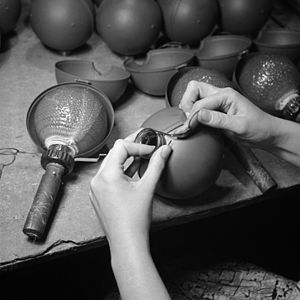Sticky bomb
| Sticky bomb | |
|---|---|

Close-up view of sticky bombs being manufactured
|
|
| Type | Anti-tank hand grenade |
| Place of origin | United Kingdom |
| Service history | |
| Used by | United Kingdom, Canada, Australia |
| Wars | World War II |
| Production history | |
| Designer | Stuart Macrae |
| Designed | 1940 |
| Manufacturer | Kay Brothers Company |
| Produced | 1940-1943 |
| No. built | 2.5 million |
| Specifications | |
| Weight | 2.25 pounds (1.02 kg) |
| Length | 9 inches (230 mm) |
| Diameter | 4 inches (100 mm) |
|
|
|
| Filling | Nitroglycerine (Nobel's No. 823 explosive) |
| Filling weight | 1.25 pounds (0.57 kg) |
|
Detonation
mechanism |
Timed, 5 seconds |
The Grenade, Hand, Anti-Tank No. 74, commonly known as the S.T. Grenade or sticky bomb, was a British hand grenade designed and produced during the Second World War. The grenade was one of a number of anti-tank weapons developed for use by the British Army and Home Guard as an ad hoc solution to a lack of sufficient anti-tank guns in the aftermath of the Dunkirk evacuation. Designed by a team from MIR(c) including Major Millis Jefferis and Stuart Macrae, the grenade consisted of a glass sphere containing an explosive made of nitroglycerin and additives (this added stability to the mix, as well as giving it its squash-head-like effect) covered in a strong adhesive and surrounded by a sheet-metal casing. When the user pulled a pin on the handle of the grenade, the casing would fall away and expose the sticky sphere. Pulling another pin would arm the firing mechanism and the user would then attempt to attach the grenade to an enemy tank or other vehicle. Letting go of the handle would release a lever that would activate a five-second fuse, which would then detonate the nitroglycerin.
The grenade had several faults with its design. In tests, it failed to adhere to dusty or muddy tanks and, if the user was not careful after freeing the grenade from its casing, it could easily stick to his uniform. The Ordnance Board of the War Department did not approve the grenade for use by the British Army, but personal intervention by the Prime Minister, Winston Churchill, led to the grenade going into production. Between 1940 and 1943, approximately 2.5 million were produced. It was primarily issued to the Home Guard, but was also used by British and Commonwealth forces in North Africa, accounting for six German tanks; used by Allied Forces on the Anzio Beachhead, including the First Special Service Force; as well as by Australian Army units during the New Guinea campaign. The French Resistance were also issued a quantity of the grenades.
...
Wikipedia
